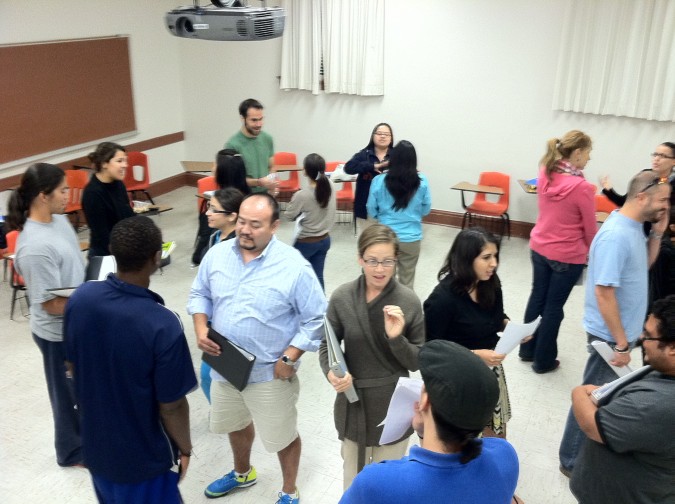By Anu Sachdev with Dr. Lucía Durá
EL PASO –“It is like therapy,” said Marlene, who found herself acknowledged in a university class. Another student, Karla, said, “I have changed!” And many more continued to chime in during casual conversation before the Tuesday evening class.
So what was happening in this class?

What is happening in this class? (©Social Justice Initiative)
I thought about my own experience as a student for over twenty years spending a good deal of time looking for the right opportunities to make myself heard. Sometimes I was successful, but most of the time my thoughts found comfort internalized within me. And then there were the times when the teacher asked a question and looked at me. The first reaction was “me?” however, this experience was different. The professor never asked one person to speak up. It might sound strange, but instead, everyone participated at the same time. This class was really different.
Dr. Arvind Singhal sits with class participants in a circle. In my first class at UTEP in the Department of Communication, I was amused…there was laughter…Participants spoke their minds.
“Wow!” I thought. “What is it that Dr. Singhal is doing?”
With all my courage, I asked, “what is it that you do to facilitate class sessions Dr. Singhal?”
Other students nodded in agreement—wanting to know more.
“Liberating structures. The same classroom, the same chairs, the same people, and exactly the same amount of time, but we design the class a little differently,” he responded.
Liberating structures are adaptable, easy to learn microstructures, which can be put to use in organizations, classrooms, and workshops. These structures change the ways members of a group interact and work together.
The classes are structured in non-traditional and circular patterns, breaking the hierarchies with no power points used in this class. This was one style, but my experience extended beyond this class to observe and learn in classes where other professors, like Dr. Eva Moya, Assistant Professor in the Department of Social Work in her classes uses various liberating structures to facilitate collective learning about community organizing. It may seem that these structures are only useful for courses where there are subjective outcomes, but I was amazed to see how Dr. Lawrence Lesser, Professor in the Department of Mathematics applied Liberating Structures to higher level Math and Statistics courses.

My Classmates and I engaged in a group conversation in Dr. Singhal’s Class. (©Social Justice Initiative)
As I discovered more, I learned that LS represent the shift Paolo Freire suggested from “Banking Model” of education in which the educators deposit knowledge into students and reward those who regurgitate that knowledge, to a problem solving approach. These structures are grounded in the field of complexity science about self-organization, diffusion of innovation and change (Kimball, 2008).
Liberating structures do not create a “free-for-all” environment; rather the facilitator maintains a well-defined but minimal structure, and freedom flourishes within its confines. They essentially add “structure”, both constraining and “liberating” by allowing for participation, engagement and exchanges (Lipmanowicz & McCandless, 2010), permitting for suitable and maximized interactions to take place.
“Classes are different physically in terms of dynamic, iterative, cyclical sense making for the individual as well as the collective,” explained Dr. Singhal in a conversation where I expressed interest to learning more.
LS participants may observe and “experience” other functional differences. The professor is the facilitator, rather than the sage on stage.
And the facilitator creates an environment of empowerment for the participants by guiding, suggesting options, or giving the group a chance to decide about the nature of their learning and the outcomes they would want to derive. An open invitation to the group (which they can either pass or reject) is given by the facilitator for participation and peer recognition with continuous review of the activities, which is a regular function.

Students participating in a Liberating Structure called “Impromptu Networking” in a Public Speaking class. (©Social Justice Initiative)
“Liberated” classrooms rely on group work to elicit the collective wisdom. Fishbowl participant, Emily, said, “it is amazing how we add to the content.” Norma (another female student) revealed, “I was so shy before, but now I feel connected to everyone in the class” These testimonies provided me with the evidence that liberating structures had helped create the conditions necessary for effective learning.
One may think that class is a place where we come to learn and be task oriented, but there is something about culture that actually influences these outcomes: trust.
Dr. Lucía Durá, Assistant Professor in the Department of English, who also uses liberating structures to facilitate class sessions at UTEP, said she has observed “students develop more points of connections, connecting with each other more in different ways.”
Liberating structures allow for interactions that are more frequent, comfortable and fluid. These exchanges happen in between the class as meaningful discussions and before and after the class about personal relationships–thus making a classroom much enjoyed than usual!
“We have become a family, a healthy community,” said Daniel, outside of class.
My experiences as a student have inspired my actions as an instructor. As a Teaching Assistant at the UTEP’s Department of Communication, I apply liberating structures in order for students to attain the best for themselves, making them self reliant, and independent. This journey for me has emphasized the significance of unpacking the association between space, minds and time in a classroom.
I experience my ‘ah-a’ moments as a facilitator when students resist sitting in rows and columns and remaining quiet when they have an idea—when learning becomes ACTIVE!


